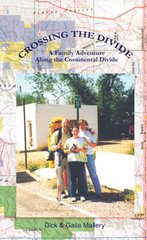The article below shows how politics erode Wilderness Protection as much as the physical presence of mountain bikes and motorized vehicles. Lately the mountain bike issue on the CDT enjoyed a large sympathy vote from many CDT hikers because so many hikers are also bikers. Lobby’s are cropping up all over the wilderness landscape and threaten to change the face and the personality of Wilderness Protection. Like so many environmental issues it is a silent invasion that creeps in like a virus. It destroys precious resources over generations of time so that what is lost has never been known to those who have lost it. —Dick Mallery

DURANGO, Colo. — In the San Juan National Forest here, an iron-rod gate is the last barrier to the Weminuche Wilderness, a mountain redoubt above 10,000 feet where wheels are not allowed.
But the gate has been knocked down repeatedly, shot at and generally disregarded. Miles beyond it, a two-track trail has been punched into the wilderness by errant all-terrain-vehicle riders who have insisted on going their own way, on-trail or off.
From Colorado's forests to Utah's sandstone canyons and the evergreen mountains of Montana, federally owned lands are rapidly being transformed into the new playgrounds — and battlegrounds — of the American West.
Outdoor enthusiasts are flocking in record numbers to lesser-known forests, deserts and mountains, where the rules of use have been lax and enforcement infrequent.
The federal government has been struggling to come up with plans to accommodate the growing numbers of off-highway vehicles — mostly with proposed maps directing them toward designated trails — but all-terrain-vehicle users have started formidable lobbying campaigns when favorite trails have been left off the maps.
Even with the plans, federal officials describe an almost impossible enforcement situation because the government does not begin to have the manpower to deal with those who will not follow the rules. To keep the lawbreakers in check, said Don Banks, the deputy state director in Salt Lake City for the federal Bureau of Land Management, the biggest landowner in states like Utah and Nevada, "You'd have to have Patton's army."
But the gate has been knocked down repeatedly, shot at and generally disregarded. Miles beyond it, a two-track trail has been punched into the wilderness by errant all-terrain-vehicle riders who have insisted on going their own way, on-trail or off.
From Colorado's forests to Utah's sandstone canyons and the evergreen mountains of Montana, federally owned lands are rapidly being transformed into the new playgrounds — and battlegrounds — of the American West.
Outdoor enthusiasts are flocking in record numbers to lesser-known forests, deserts and mountains, where the rules of use have been lax and enforcement infrequent.
The federal government has been struggling to come up with plans to accommodate the growing numbers of off-highway vehicles — mostly with proposed maps directing them toward designated trails — but all-terrain-vehicle users have started formidable lobbying campaigns when favorite trails have been left off the maps.
Even with the plans, federal officials describe an almost impossible enforcement situation because the government does not begin to have the manpower to deal with those who will not follow the rules. To keep the lawbreakers in check, said Don Banks, the deputy state director in Salt Lake City for the federal Bureau of Land Management, the biggest landowner in states like Utah and Nevada, "You'd have to have Patton's army."
The growing allure of the federal lands coincides with marked changes in how people play, with outdoor recreation now a multibillion-dollar industry. It also comes at a time, according to data compiled by Volker C. Radeloff of the University of Wisconsin, when more than 28 million homes sit less than 30 miles from federally owned land that millions of people increasingly view as their extended back yards.
"Forty years ago when I was out cowboying, I never saw a soul," said Heidi Redd, who operates the Dugout Ranch near Canyonlands National Park in southeastern Utah. "Now it's at a point where you realize the public land is not yours, you're just one of the users. And whether it's ATVs, horses or climbers, it's a traffic jam."
Any user can contribute to the traffic jam, but the off-highway vehicles do damage disproportionate to their numbers. In addition to loud engines, they have soft tires and deep treads that bite more deeply than a foot or a hoof. When they go off-trail, consequences often follow: erosion, destruction of fragile desert soils or historical artifacts and disturbance of wildlife habitats.
The temptation to go off-trail, legally or not, comes from the desire for variety, federal land managers say. "The more a route is used, the less challenging it becomes," said Mark Stiles, the San Juan forest supervisor. "You end up getting lots of little spurs off the main route." Even a few errant riders, he said, "can do a lot of damage."
Visitor numbers soar
The federal government does a spotty job counting the visitors to public lands — most do not have traditional visitors centers or staffed entry gates — but recent estimates by federal land managers in Utah signal the trend.
About 2.7 million people participated in outdoor activities on federal lands near Arches National Park so far this year, roughly double the estimates for 2000. And the number of participants in off-highway vehicle trips grew twice as fast as those in other activities, including things like rafting and sightseeing.
This explosive growth — coming at a time when attendance at many of the country's prized national parks has been below historic highs — has reignited the debate over just what should be done with the country's public lands.
In eastern Utah, six offices of the federal land management agency recently released proposed land-use plans that, among other things, cover recreational uses and the closing of areas to all-terrain vehicles. The proposals have drawn fierce reactions.
Campaigns to save popular trails have cropped up on the Internet. "Help us Save Factory Butte," says one appeal, in reference to a rock formation, a favorite area for daring motorcyclists and ATV riders that was closed on an emergency basis last year to protect cactuses. Another appeal says that a proposal to fence off cottonwood trees at White Wash Dunes near Moab, a popular playground for all-terrain vehicles, "must be opposed, en masse, by the off-highway community."
On the other side, opponents of the trails have been alarmed that the proposed networks of authorized paths would permanently eliminate large areas of Utah's unroaded wild lands from consideration as federally protected wilderness areas.
Members of the Southern Utah Wilderness Alliance, an environmental group that wants greater restrictions placed on motorized users, have tallied the total miles of motorized trails that would be allowed (about 15,000 miles) and the number of currently roadless acres that would no longer be eligible for federal wilderness protections (more than 2.5 million acres).
Lawyers for the group estimate that 82 percent of the lands in Utah that the Bureau of Land Management said had wilderness character in 1999 are now open for energy, mining or motorized recreation.
"Everybody's losing something they thought they had," said Clifton Koontz, an avid dirt-motorbike rider and co-founder of Ride With Respect, a group that teaches people about the bikes and how to minimize damage to the environment.
A balancing act
The preservation movement that coalesced around John Muir in the late 19th century focused on setting aside public lands, first as parks, then wildlife refuges, then after passage of the 1964 Wilderness Act, as wilderness areas "untrammeled by man."
But by the 1990s, federal designations were increasingly disputed by the mining and energy industries. Groups representing makers and riders of off-highway vehicles also had objections, casting the suggested wilderness designations as hostile acts designed to strip riders of their rights.
"They want everybody out," said Russ Englund, who owns a motorcycle shop outside the Bitterroot National Forest, which straddles the Montana-Idaho border and is one of the many flash points. "They think it has to be kept in this pristine state. These people don't even use it."
Riders of all varieties complain that their critics are off the mark, that motorized sports are about more than a handful of renegades. They say the activities are enjoyed in large part by law-abiding families and that the motorized vehicles allow older people and the infirm to visit beautiful and remote places otherwise inaccessible to them.
"I don't like being looked at as a bad guy all the time," said Bob Turri, 79, who likes to ride his all-terrain vehicle near his home in Monticello in southeastern Utah.
On a recent trip to Hidden Canyon, 20 miles from Moab and two miles from the nearest paved road, Koontz of Ride With Respect said it was possible to design trails that separated the machines from the wildlife.
Bighorn sheep sometimes visit Hidden Canyon, and Koontz pointed to the faint sheep tracks crossing the imprint of tires.
"You build the trails below the ridgelines," he said, explaining that sheep, when startled, are more comfortable heading up to ridges rather than down into canyons, and therefore would naturally stay away from the riders.
But federal managers say the outlaw fringe of motor-vehicle users is driving the need for more regulation. While sales of all-terrain vehicles have dipped slightly since 2004, the slippage comes after astronomical growth. Registrations of all-terrain vehicles and motorbikes in Utah, California, Colorado and Idaho tripled from 1998 to 2006; in Riverside County, east of Los Angeles and a couple hours drive from the popular Algodones Dunes, registrations went up fourfold. In Wyoming, the registration increases were starker: up fivefold, to 45,000, from 2002 to 2006.
Many motorized users say wealthy homeowners are selfish, pushing for restrictions to preserve postcard views. So-called quiet users, those who do not use motorcycles or all-terrain vehicles, often portray those riders as reckless people in their 20s who seek out meadows simply to shred them.
Not so black and white
In truth, there are some young thrill-seekers and wealthy armchair environmentalists, but the demographics on both sides are complicated.
Many all-terrain-vehicle riders take their grandchildren with them and go fishing. In Utah, where in some rural counties there is one off-highway vehicle for every three or four people, 8-year-olds ride scaled-down versions and older people use them for Sunday outings.
Many quiet users, meanwhile, are not rich newcomers but longtime locals who spent their lives in the forest. One of them, Tom Powers, a backcountry hunter in Montana who first hunted elk in the Bitterroot as a young man in 1969, still takes his horse into the woods, but less than before, to avoid the summertime traffic of motorcycles, pickups and all-terrain vehicles.
"They've ruined what used to be a quality experience in the backcountry, where you were just up there with nature," Powers said.
The list of complaints is long and varied.
Though some hunters enjoy all-terrain vehicles, others complain that hunters using them get so close that their engines spook the game.
"There are so many of these machines," said Dave Petersen, a bow hunter who monitors public lands issues in Durango for the environmental group Trout Unlimited. "It's made our big public lands much smaller, for the wildlife and for us."
Environmentalists worry about the destruction of fragile soils and erosion, when outsize Western rainfalls course through the ruts left by hill-climbing all-terrain vehicles. There are also concerns for streams, rivers and wetlands, precious resources in the arid West and magnets for those who think all-terrain-vehicle riding is best when muddy. "They wouldn't do this in their back yard," said Liz Thomas, a lawyer for the Southern Utah Wilderness Alliance. "But it's not their back yard."
Trespassing is another problem. Since most land used for outdoor recreation is publicly owned, some riders and hikers pay little heed to "No Trespassing" signs on property that abuts popular federal lands. The hikers are not hard to identify and prosecute, but the all-terrain-vehicle riders can be. A Colorado man, Joe Jepson, ordered two riders off his land last year. One ran him down, breaking his leg. The riders were never identified.
Perhaps the biggest damage to the sport's reputation has come from mass holiday gatherings that have turned ugly or dangerous on public lands like Algodones Dunes in California, a favorite spot at New Year's. Last Easter weekend at the Little Sahara sand dunes in Utah — a popular spring-break getaway like Florida's beaches — there was a near-riot, with, among other things, drunken riders forcing women to expose their breasts. ATV fans argue that drunken rowdies are not unique to any particular group.
"We have two groups, one that wants to be quiet and then one that wants to have motorized use," said Mary Laws, the recreation program manager for Bitterroot National Forest. "They both want to be in the forest, so we get the great task of coming up somewhere in the middle."
"Forty years ago when I was out cowboying, I never saw a soul," said Heidi Redd, who operates the Dugout Ranch near Canyonlands National Park in southeastern Utah. "Now it's at a point where you realize the public land is not yours, you're just one of the users. And whether it's ATVs, horses or climbers, it's a traffic jam."
Any user can contribute to the traffic jam, but the off-highway vehicles do damage disproportionate to their numbers. In addition to loud engines, they have soft tires and deep treads that bite more deeply than a foot or a hoof. When they go off-trail, consequences often follow: erosion, destruction of fragile desert soils or historical artifacts and disturbance of wildlife habitats.
The temptation to go off-trail, legally or not, comes from the desire for variety, federal land managers say. "The more a route is used, the less challenging it becomes," said Mark Stiles, the San Juan forest supervisor. "You end up getting lots of little spurs off the main route." Even a few errant riders, he said, "can do a lot of damage."
Visitor numbers soar
The federal government does a spotty job counting the visitors to public lands — most do not have traditional visitors centers or staffed entry gates — but recent estimates by federal land managers in Utah signal the trend.
About 2.7 million people participated in outdoor activities on federal lands near Arches National Park so far this year, roughly double the estimates for 2000. And the number of participants in off-highway vehicle trips grew twice as fast as those in other activities, including things like rafting and sightseeing.
This explosive growth — coming at a time when attendance at many of the country's prized national parks has been below historic highs — has reignited the debate over just what should be done with the country's public lands.
In eastern Utah, six offices of the federal land management agency recently released proposed land-use plans that, among other things, cover recreational uses and the closing of areas to all-terrain vehicles. The proposals have drawn fierce reactions.
Campaigns to save popular trails have cropped up on the Internet. "Help us Save Factory Butte," says one appeal, in reference to a rock formation, a favorite area for daring motorcyclists and ATV riders that was closed on an emergency basis last year to protect cactuses. Another appeal says that a proposal to fence off cottonwood trees at White Wash Dunes near Moab, a popular playground for all-terrain vehicles, "must be opposed, en masse, by the off-highway community."
On the other side, opponents of the trails have been alarmed that the proposed networks of authorized paths would permanently eliminate large areas of Utah's unroaded wild lands from consideration as federally protected wilderness areas.
Members of the Southern Utah Wilderness Alliance, an environmental group that wants greater restrictions placed on motorized users, have tallied the total miles of motorized trails that would be allowed (about 15,000 miles) and the number of currently roadless acres that would no longer be eligible for federal wilderness protections (more than 2.5 million acres).
Lawyers for the group estimate that 82 percent of the lands in Utah that the Bureau of Land Management said had wilderness character in 1999 are now open for energy, mining or motorized recreation.
"Everybody's losing something they thought they had," said Clifton Koontz, an avid dirt-motorbike rider and co-founder of Ride With Respect, a group that teaches people about the bikes and how to minimize damage to the environment.
A balancing act
The preservation movement that coalesced around John Muir in the late 19th century focused on setting aside public lands, first as parks, then wildlife refuges, then after passage of the 1964 Wilderness Act, as wilderness areas "untrammeled by man."
But by the 1990s, federal designations were increasingly disputed by the mining and energy industries. Groups representing makers and riders of off-highway vehicles also had objections, casting the suggested wilderness designations as hostile acts designed to strip riders of their rights.
"They want everybody out," said Russ Englund, who owns a motorcycle shop outside the Bitterroot National Forest, which straddles the Montana-Idaho border and is one of the many flash points. "They think it has to be kept in this pristine state. These people don't even use it."
Riders of all varieties complain that their critics are off the mark, that motorized sports are about more than a handful of renegades. They say the activities are enjoyed in large part by law-abiding families and that the motorized vehicles allow older people and the infirm to visit beautiful and remote places otherwise inaccessible to them.
"I don't like being looked at as a bad guy all the time," said Bob Turri, 79, who likes to ride his all-terrain vehicle near his home in Monticello in southeastern Utah.
On a recent trip to Hidden Canyon, 20 miles from Moab and two miles from the nearest paved road, Koontz of Ride With Respect said it was possible to design trails that separated the machines from the wildlife.
Bighorn sheep sometimes visit Hidden Canyon, and Koontz pointed to the faint sheep tracks crossing the imprint of tires.
"You build the trails below the ridgelines," he said, explaining that sheep, when startled, are more comfortable heading up to ridges rather than down into canyons, and therefore would naturally stay away from the riders.
But federal managers say the outlaw fringe of motor-vehicle users is driving the need for more regulation. While sales of all-terrain vehicles have dipped slightly since 2004, the slippage comes after astronomical growth. Registrations of all-terrain vehicles and motorbikes in Utah, California, Colorado and Idaho tripled from 1998 to 2006; in Riverside County, east of Los Angeles and a couple hours drive from the popular Algodones Dunes, registrations went up fourfold. In Wyoming, the registration increases were starker: up fivefold, to 45,000, from 2002 to 2006.
Many motorized users say wealthy homeowners are selfish, pushing for restrictions to preserve postcard views. So-called quiet users, those who do not use motorcycles or all-terrain vehicles, often portray those riders as reckless people in their 20s who seek out meadows simply to shred them.
Not so black and white
In truth, there are some young thrill-seekers and wealthy armchair environmentalists, but the demographics on both sides are complicated.
Many all-terrain-vehicle riders take their grandchildren with them and go fishing. In Utah, where in some rural counties there is one off-highway vehicle for every three or four people, 8-year-olds ride scaled-down versions and older people use them for Sunday outings.
Many quiet users, meanwhile, are not rich newcomers but longtime locals who spent their lives in the forest. One of them, Tom Powers, a backcountry hunter in Montana who first hunted elk in the Bitterroot as a young man in 1969, still takes his horse into the woods, but less than before, to avoid the summertime traffic of motorcycles, pickups and all-terrain vehicles.
"They've ruined what used to be a quality experience in the backcountry, where you were just up there with nature," Powers said.
The list of complaints is long and varied.
Though some hunters enjoy all-terrain vehicles, others complain that hunters using them get so close that their engines spook the game.
"There are so many of these machines," said Dave Petersen, a bow hunter who monitors public lands issues in Durango for the environmental group Trout Unlimited. "It's made our big public lands much smaller, for the wildlife and for us."
Environmentalists worry about the destruction of fragile soils and erosion, when outsize Western rainfalls course through the ruts left by hill-climbing all-terrain vehicles. There are also concerns for streams, rivers and wetlands, precious resources in the arid West and magnets for those who think all-terrain-vehicle riding is best when muddy. "They wouldn't do this in their back yard," said Liz Thomas, a lawyer for the Southern Utah Wilderness Alliance. "But it's not their back yard."
Trespassing is another problem. Since most land used for outdoor recreation is publicly owned, some riders and hikers pay little heed to "No Trespassing" signs on property that abuts popular federal lands. The hikers are not hard to identify and prosecute, but the all-terrain-vehicle riders can be. A Colorado man, Joe Jepson, ordered two riders off his land last year. One ran him down, breaking his leg. The riders were never identified.
Perhaps the biggest damage to the sport's reputation has come from mass holiday gatherings that have turned ugly or dangerous on public lands like Algodones Dunes in California, a favorite spot at New Year's. Last Easter weekend at the Little Sahara sand dunes in Utah — a popular spring-break getaway like Florida's beaches — there was a near-riot, with, among other things, drunken riders forcing women to expose their breasts. ATV fans argue that drunken rowdies are not unique to any particular group.
"We have two groups, one that wants to be quiet and then one that wants to have motorized use," said Mary Laws, the recreation program manager for Bitterroot National Forest. "They both want to be in the forest, so we get the great task of coming up somewhere in the middle."
MORE BACKPACKING AND HIKING NEWS AT: thenewspaperthatwalks.com































